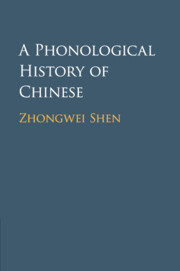Book contents
- A Phonological History of Chinese
- A Phonological History of Chinese
- Copyright page
- Contents
- Figures
- Tables
- Foreword by William S-Y. Wang 王士元
- Preface
- Major Periods of Chinese History
- Locations of Ancient Capitals of China
- Part I The Keys to Traditional Phonology
- Part II Old Chinese
- Part III Middle Chinese
- Part IV The Beginnings of Mandarin
- Part V A New Standard
- 6 Old Mandarin: The Ménggǔ Zìyùn 蒙古字韻
- 7 Old Mandarin: The Zhōngyuán Yīnyùn 中原音韻
- 8 Old Mandarin: The Persian Transcriptions
- Part VI Toward Modern Mandarin
- References
- Index
8 - Old Mandarin: The Persian Transcriptions
from Part V - A New Standard
Published online by Cambridge University Press: 09 June 2020
- A Phonological History of Chinese
- A Phonological History of Chinese
- Copyright page
- Contents
- Figures
- Tables
- Foreword by William S-Y. Wang 王士元
- Preface
- Major Periods of Chinese History
- Locations of Ancient Capitals of China
- Part I The Keys to Traditional Phonology
- Part II Old Chinese
- Part III Middle Chinese
- Part IV The Beginnings of Mandarin
- Part V A New Standard
- 6 Old Mandarin: The Ménggǔ Zìyùn 蒙古字韻
- 7 Old Mandarin: The Zhōngyuán Yīnyùn 中原音韻
- 8 Old Mandarin: The Persian Transcriptions
- Part VI Toward Modern Mandarin
- References
- Index
Summary
Quite systematic transliterations of Chinese can be found in the Persian documents created in the Persian part of the Mongol Empire (1256-1353). A fairly large number of the transcriptions of Chinese words can be found in two books. One is Rashid al Din’s History of China, which is a part of his world history (Tārīkh-i Chīn az Jāmiʻ al-Tavārīkh). The other is Mài Jué 脈訣, which is an annotated translation into Persian of a Chinese medical treatise in verses. The transcriptions were based on the colloquial Chinese pronunciation, and thus they can provide us the phonetic information that cannot be retrieved from the Chinese categorical materials. The Persian transcriptions of Mài Jué show very interesting variations of individuals’ spoken language. Some are quite close to the features of the capital dialect, and some only show certain features of the Mandarin dialect while maintaining obvious non-Mandarin features of the southern dialects. Thus, it is very possible that in the process of the translation project, the translator introduced dialectal features into their pronunciation of Mandarin.
Keywords
- Type
- Chapter
- Information
- A Phonological History of Chinese , pp. 294 - 316Publisher: Cambridge University PressPrint publication year: 2020



